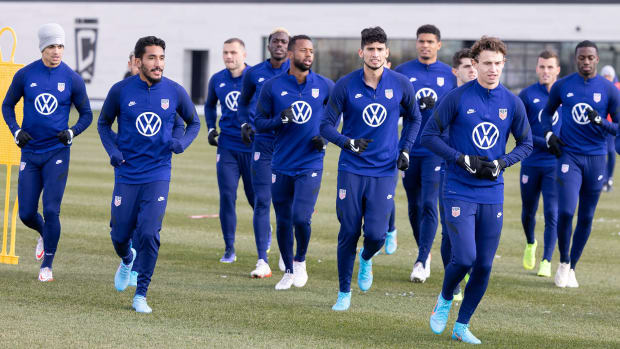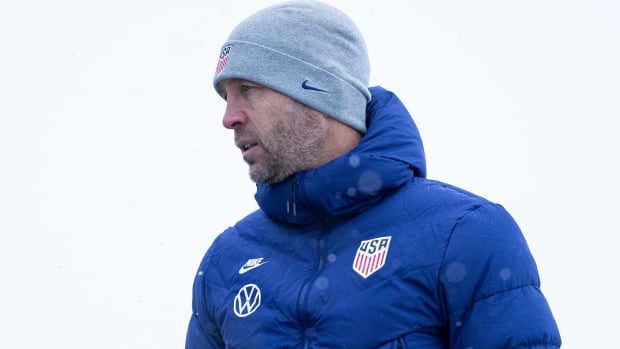It has been established quite emphatically that it's going to be cold. Nearly half of the squad is out of season. Some key players are hurt. Others have their club careers in the balance, with MLS trades and potential European transfers swirling. One player has had travel issues just getting to camp. Generally speaking, the conditions are not ideal for the U.S. men's national team entering the penultimate World Cup qualifying window.
It's not a vacuum, though. The U.S.'s fortunes over the course of the next three matches are tied to those of their opponents as well. And those opponents are not exactly operating under optimum circumstances, either.
Take Thursday's opponent El Salvador, for instance, a team that held the U.S. to a scoreless draw in the opening match of World Cup qualifying but has only five points since and has been all but reduced to playing spoiler. It's not going to be accustomed to the frigid temperatures of Ohio, nor is it slated to be entirely at full strength (El Gráfico reports the two center backs who started vs. the U.S. in September may not be available Thursday). Last-place Honduras, which the U.S. will play to close the window, is also all but eliminated, is on its second coach of the Concacaf Octagonal and, like its fellow Central American nation, should not be playing at its peak in the Minnesota cold. That's the logic from the USMNT side, which systematically chose its two home locations for this window by prioritizing shorter travel for the middle match—at first-place Canada, in Hamilton, Ontario—while creating layers of complications for its other opponents and ensuring a partisan crowd.

John Dorton/ISI Photos/Getty Images
“We know a large portion of our guys are playing in Europe. They’re playing in cold weather right now,” U.S. coach Gregg Berhalter said last month. “They should be able to adapt pretty nicely.
"If it’s tough for us, and we have guys playing in Europe in cold weather, what’s it going to be like for Honduras, who's coming from Honduras midweek, coming from 85-, 90-degree temperatures?”
There's an acknowledgement that forcing the U.S. players to also contend with the cold isn't ideal, either. But then again, braving and taming the elements while subjecting opponents from warmer climates to them has traditionally been a badge of honor for this team, a rite of passage of sorts. Welcoming Mexico to Columbus in the cold months began with "La Guerra Fria" over 20 years ago, and playing Costa Rica through a Colorado blizzard set the stage for the famous "Snowclasico" of the 2014 qualifying cycle. These are the games that can strengthen a team's bond if things go right, and while it's rare to find a player who will admit to preferring elements like that if given the choice, it's not exactly a foreign concept for some in U.S. camp.
“It’s obviously cold out here, but something that I’ve been used to growing up in New York and playing academy games throughout the winter on turf fields," U.S. star midfielder Tyler Adams said from Columbus, where the temperature at first kick Thursday is slated to be in the high 20s. "You’re used to this, pushing the snow to the side and being able to play and enjoy it. The cold is not going to stop us from doing what we do. If anything, it’s just going to cause us to run a little bit more to stay warm.”
Added center back Walker Zimmerman: “I was even talking to my wife over the break. I was like, you know what? I want it to be freezing. I want it to be cold. I want the snow. I want to be a part of something so iconic that I saw and I really remember growing up. And that’s exciting to me. So I think the guys are ready to embrace it, embrace the cold. And it will be a really good environment for us fan-wise, as well.”
The cold is no obstacle for Canada, which enjoyed a famous win over Mexico in frigid Edmonton at a stadium that was, temporarily anyway, renamed the "Iceteca" as a nod to Mexico's Estadio Azteca. But the current first-place side will be missing its top attraction, with Bayern Munich left back Alphonso Davies out as he recovers from myocarditis following a positive COVID-19 diagnosis. The coronavirus has impacted another key cog for the Canadians as well, with midfielder Stephen Eustáquio recently testing positive. His availability for Canada this window remains in question. Nine of Canada's 25 players are based in MLS and thus facing the same out-of-season dilemma that 13 of the U.S. players have been combatting. Two key components out wide, Tajon Buchanan and Richie Laryea, just completed transfers to new clubs overseas and are in the midst of that transition.
There's also the matter of Canada's home-field advantage. The crowd surrounding the turf field at Hamilton's Tim Hortons Stadium has been limited to 50% capacity due to COVID-19 protocols, with the Canadian Soccer Association canceling and refunding all of the 24,000 tickets it had sold before reselling 12,000. It'll be loud and partisan, just not as much as initially planned.

John Dorton/ISI Photos/Getty Images
This entire qualifying process has been about navigating through adversity. The three-game windows have put more stress on squads than any previous qualifying campaigns. For the U.S., specifically, it has never had what most would consider its ideal XI all on the field together, not during qualifying or before it. You'll often hear coaches talking about how their teams need to suffer to find success. There will be plenty of suffering over the course of the next week, physically and psychologically. The U.S. is banking on the fact that its ability to absorb all of that exceeds that of its three opponents, and by doing so takes the Americans that much closer to the hotter locale that has been its target destination all this time: the 2022 World Cup in Qatar.
“Understand that mentality and what it takes to succeed in those moments,” said goalkeeper Matt Turner, who is in line to start with Zack Steffen suffering from back tightness and yet to join the team from Man City. “So for me, it’s embracing the cold. It’s keep up my focus sharp for the moments when I’m called into action and just have fun with it. I mean, this is America. This is the beauty. We could play in 90 degrees and we can play in zero degrees in the same time of year. It’s a pretty cool thing."







